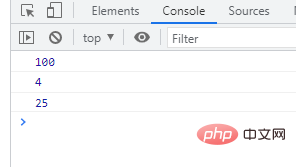 Web Front-end
Web Front-end
 JS Tutorial
JS Tutorial
 Detailed explanation of JavaScript function return values and return statements
Detailed explanation of JavaScript function return values and return statements
Detailed explanation of JavaScript function return values and return statements
The JavaScript function provides two interfaces to interact with the outside world. The parameters serve as the entrance to receive external information; the return value serves as the exit to feed back the operation results to the outside world. The following article will take you to understand the JavaScript function return value and briefly analyze the usage of the return statement. I hope it will be helpful to you!

A function is a collection of functions that can implement certain specific functions or operations. It makes no sense to keep the result after the function is run inside the function, so we need to return the result of the function to the place where the function is called.
In the function body, use the return statement to set the return value of the function; the return statement is usually defined at the end of the function. Grammar format:
return 返回值;
Among them, "return value" is an optional parameter, which can be a specific value or expression, or it can be empty. The "return value" and the return keyword need to be separated by a space.
JavaScript is a weakly typed language, so functions have no type restrictions on the values they receive and output, and JavaScript does not automatically detect the types of input and output values. Therefore, the return value (expression result) can be of any type, such as array, object, string, etc.
For functions that have a return value, we can use a variable to receive the return value of this function. The sample code is as follows:
//声明一个带返回值的函数
function getSum(num1, num2){
//函数体
return num1 + num2;
}
//可以通过变量来接收这个返回值
var sum1 = getSum(7, 12); // 函数返回值为:19
var sum2 = getSum(-5, 33); // 函数返回值为:28If the function does not contain a return statement, the
undefinedvalue will be returned after each statement in the function body is executed.

In the function, once the "return" statement is executed, the entire function ends. The statement will no longer be executed ; then the value of the expression following return is evaluated and returned.

The value after "return" can only have one . If you try to return multiple values, the result will always be the last value

return statement can only return one parameter , that is, only one value can be returned, and multiple values cannot be returned at one time. If you want to return multiple values, you need to define an array in the function, store the return value in the array and return it.
function division(dividend, divisor){
var quotient = dividend / divisor;
var arr = [dividend, divisor, quotient]
return arr;
}
var res = division(100, 4)
console.log(res[0]); // 输出:100
console.log(res[1]); // 输出:4
console.log(res[2]); // 输出:25In the above code, the function return value is an array, which contains 3 elements, thus achieving the purpose of using a return statement to return multiple values.

The function body can contain multiple return statements, but only one return statement can be executed, so the branch structure can be used in the function body to determine the function return value, or use the return statement to terminate function execution early.
function f(x,y) {
//如果参数为非数字类型,则终止函数执行
if (typeof x != "number" || typeof y != "number") return;
//根据条件返回值
if (x > y) return x - y;
if (x < y) return y - x;
if (x * y <= 0) return x + y;
}
console.log(f(1,6));
console.log(f(4,2));
console.log(f(0,0));Summary:
The return statement is used to call a function "or" returns a value. After returning the value, the function execution ends immediately, so the return statement is generally placed at the end of the function;
If there are multiple return statements in a function, only The first one will be executed;
The return statement may not return parameters, which is equivalent to ending the function running;
[Related recommendations:javascript learning tutorial】
The above is the detailed content of Detailed explanation of JavaScript function return values and return statements. For more information, please follow other related articles on the PHP Chinese website!

Hot AI Tools

Undresser.AI Undress
AI-powered app for creating realistic nude photos

AI Clothes Remover
Online AI tool for removing clothes from photos.

Undress AI Tool
Undress images for free

Clothoff.io
AI clothes remover

AI Hentai Generator
Generate AI Hentai for free.

Hot Article

Hot Tools

Notepad++7.3.1
Easy-to-use and free code editor

SublimeText3 Chinese version
Chinese version, very easy to use

Zend Studio 13.0.1
Powerful PHP integrated development environment

Dreamweaver CS6
Visual web development tools

SublimeText3 Mac version
God-level code editing software (SublimeText3)

Hot Topics
 1377
1377
 52
52
 How to implement an online speech recognition system using WebSocket and JavaScript
Dec 17, 2023 pm 02:54 PM
How to implement an online speech recognition system using WebSocket and JavaScript
Dec 17, 2023 pm 02:54 PM
How to use WebSocket and JavaScript to implement an online speech recognition system Introduction: With the continuous development of technology, speech recognition technology has become an important part of the field of artificial intelligence. The online speech recognition system based on WebSocket and JavaScript has the characteristics of low latency, real-time and cross-platform, and has become a widely used solution. This article will introduce how to use WebSocket and JavaScript to implement an online speech recognition system.
 WebSocket and JavaScript: key technologies for implementing real-time monitoring systems
Dec 17, 2023 pm 05:30 PM
WebSocket and JavaScript: key technologies for implementing real-time monitoring systems
Dec 17, 2023 pm 05:30 PM
WebSocket and JavaScript: Key technologies for realizing real-time monitoring systems Introduction: With the rapid development of Internet technology, real-time monitoring systems have been widely used in various fields. One of the key technologies to achieve real-time monitoring is the combination of WebSocket and JavaScript. This article will introduce the application of WebSocket and JavaScript in real-time monitoring systems, give code examples, and explain their implementation principles in detail. 1. WebSocket technology
 How to use JavaScript and WebSocket to implement a real-time online ordering system
Dec 17, 2023 pm 12:09 PM
How to use JavaScript and WebSocket to implement a real-time online ordering system
Dec 17, 2023 pm 12:09 PM
Introduction to how to use JavaScript and WebSocket to implement a real-time online ordering system: With the popularity of the Internet and the advancement of technology, more and more restaurants have begun to provide online ordering services. In order to implement a real-time online ordering system, we can use JavaScript and WebSocket technology. WebSocket is a full-duplex communication protocol based on the TCP protocol, which can realize real-time two-way communication between the client and the server. In the real-time online ordering system, when the user selects dishes and places an order
 How to implement an online reservation system using WebSocket and JavaScript
Dec 17, 2023 am 09:39 AM
How to implement an online reservation system using WebSocket and JavaScript
Dec 17, 2023 am 09:39 AM
How to use WebSocket and JavaScript to implement an online reservation system. In today's digital era, more and more businesses and services need to provide online reservation functions. It is crucial to implement an efficient and real-time online reservation system. This article will introduce how to use WebSocket and JavaScript to implement an online reservation system, and provide specific code examples. 1. What is WebSocket? WebSocket is a full-duplex method on a single TCP connection.
 JavaScript and WebSocket: Building an efficient real-time weather forecasting system
Dec 17, 2023 pm 05:13 PM
JavaScript and WebSocket: Building an efficient real-time weather forecasting system
Dec 17, 2023 pm 05:13 PM
JavaScript and WebSocket: Building an efficient real-time weather forecast system Introduction: Today, the accuracy of weather forecasts is of great significance to daily life and decision-making. As technology develops, we can provide more accurate and reliable weather forecasts by obtaining weather data in real time. In this article, we will learn how to use JavaScript and WebSocket technology to build an efficient real-time weather forecast system. This article will demonstrate the implementation process through specific code examples. We
 Simple JavaScript Tutorial: How to Get HTTP Status Code
Jan 05, 2024 pm 06:08 PM
Simple JavaScript Tutorial: How to Get HTTP Status Code
Jan 05, 2024 pm 06:08 PM
JavaScript tutorial: How to get HTTP status code, specific code examples are required. Preface: In web development, data interaction with the server is often involved. When communicating with the server, we often need to obtain the returned HTTP status code to determine whether the operation is successful, and perform corresponding processing based on different status codes. This article will teach you how to use JavaScript to obtain HTTP status codes and provide some practical code examples. Using XMLHttpRequest
 How to get HTTP status code in JavaScript the easy way
Jan 05, 2024 pm 01:37 PM
How to get HTTP status code in JavaScript the easy way
Jan 05, 2024 pm 01:37 PM
Introduction to the method of obtaining HTTP status code in JavaScript: In front-end development, we often need to deal with the interaction with the back-end interface, and HTTP status code is a very important part of it. Understanding and obtaining HTTP status codes helps us better handle the data returned by the interface. This article will introduce how to use JavaScript to obtain HTTP status codes and provide specific code examples. 1. What is HTTP status code? HTTP status code means that when the browser initiates a request to the server, the service
 What is the type of return value of Golang function?
Apr 13, 2024 pm 05:42 PM
What is the type of return value of Golang function?
Apr 13, 2024 pm 05:42 PM
Go functions can return multiple values of different types. The return value type is specified in the function signature and returned through the return statement. For example, a function can return an integer and a string: funcgetDetails()(int,string). In practice, a function that calculates the area of a circle can return the area and an optional error: funccircleArea(radiusfloat64)(float64,error). Note: If the function signature does not specify a type, a null value is returned; it is recommended to use a return statement with an explicit type declaration to improve readability.




